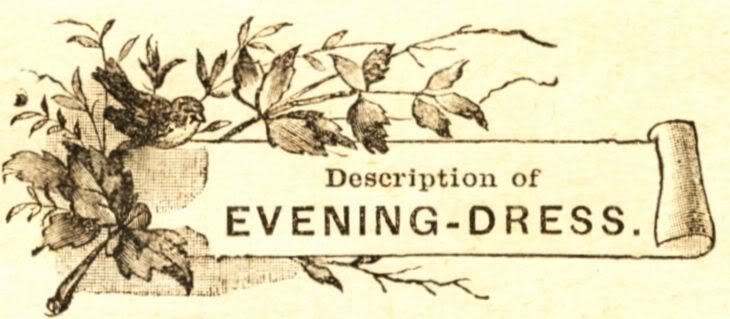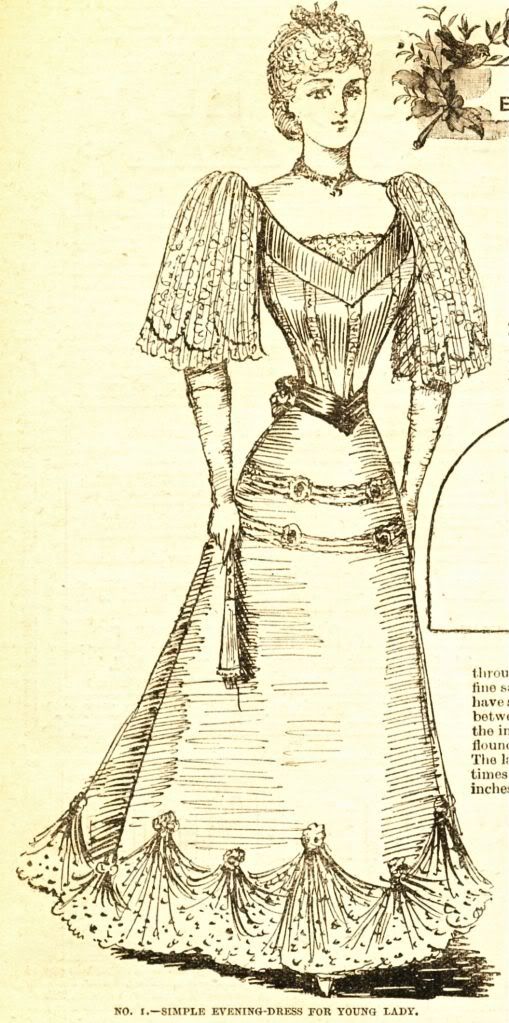And consider that materials list, yards and yards of fabric all for this one gown. But we are thoughtfully provided with an advertiser who can sell us exactly what we need.
So let's go dancing!
"This simple yet stylish little dress is suitable to be made in a variety of materials; corded silk, a soft lusterous satin, brocade, or for a less expensive dress material, crepon is pretty. Our model is of shell-pink satin, trimmed with cream lace, and pearl beaded trimming."
"The skirt is made just to touch the ground, as this is the most convenient length for dancing. The cut-out pattern of skirt that we gave with the November Part will answer perfectly well to cut to this to; it should be lined throughout with pink glace silk or fine sateen. The foot of skirt should have stiff muslin 10 inches deep inserted between the satin and the lining, and the inside edge is finished with a pinked flounce 6 inches deep of the glace silk. The lace flounce must be at least three times the width of the skirt, and is 10 inches deep, put on as festoons as follows: Gather the edge of the lace and put it on in the full depth to form a sort of fan; the upper edge is drawn up quite tightly, and the stitches are covered with a rosette of bebe ribbon or a pearl ornament; slant the lace down 4 1/2 inches, pleat it to two-thirds the original width, gather slightly to make it set well, and sew it under a rosette; slant it upwards and gather again at the edge; a little practice will soon enable a novice to arrange the lace gracefully; it is best to pin three or four of the festoons before sewing, so as to be quite certain the lace does not drag anywhere. The upper part of the skirt is trimmed with two rows of pearl passementerie; the upper one is 9 inches from the waist; the second 3 inches lower down. "
"The diagrams for the bodice are shown in No. 2. The bodice fronts are joined down the centre, and are cut on the straight. The large side pieces next front as well as those next to them are cut on the cross, and lining the same way, as it makes the bodice fit much better. The back and side pieces back are cut on the straight. A bone is sewn in at the edge of each half of the back; the eyelet holes through which the lace is passed are worked just inside the bone. Each seam must be carefully boned, and the edge of the basque is piped. the top is turned down a piece of ribbon 3/4 inch wide; through this a draw string of narrow ribbon is run; this is not an absolute necessity, but it makes the bodice set well over the shoulders; the ribbon chosen for the draw string should be a good soft, strong make so as to prevent the possibilty of breaking.
In fitting the bodice, great care should be taken that it sets well, and tightly under the arm. The bodice is trimmed with perpendicular rows of pearl passementerie or a lace insertion; the edge of top is trimmed with a crossfold of satin, and stomacher of lace.
The pointed belt is composed of folds of satin, finished by a rosette at the back.
No. 3, the sleeves are of accordian-pleated lace. For the pleating, 78 inches of lace must be allowed for each sleeve, this is three times the width of the sleeve. The pleated lace must be laid flat on the table and cut out to the pattern shown in No. 3. Before cutting out tack the pleats of lace to shape of pattern, this will prevent the pleats coming out when the lace is cut. Gather the lace at the top of arm, and set it into the armholes as you would plain material."
"Messer. J. Sands and Co, Thurland Street, Nottingham, have sent us for notice some patterns of lovely lace, ranging in price from 5 1/2d. to 2 s. 6d per yard. There is a very good imitation of Honiton lace 10 inches wide, suitable for the flounce of this dress, at 2s. 6d. per yard; a less expensive is mauresque that is the same width at 1s. per yard. They also send patterns of a pretty striped gauze, which would make up beautifully in this style over a plain silk lining. The gauze is satin striped, and is woven with lace insertion at intervals of about 3 inches.
MATERIALS REQUIRED; 10 yards satin, 12 yards silk for lining, 2 yards stiff muslin, 5 yards lace 19 inches wide for sleeves, 12 yards lace for flounce, 3 yards insertion or passementerie or lace for insertion.
We endeavour to make our diagrams as clear as possible, but those of our readers who are unable to cut the bodice from our diagrams, can have the flat pattern sent by post for 6 1/2d. "













